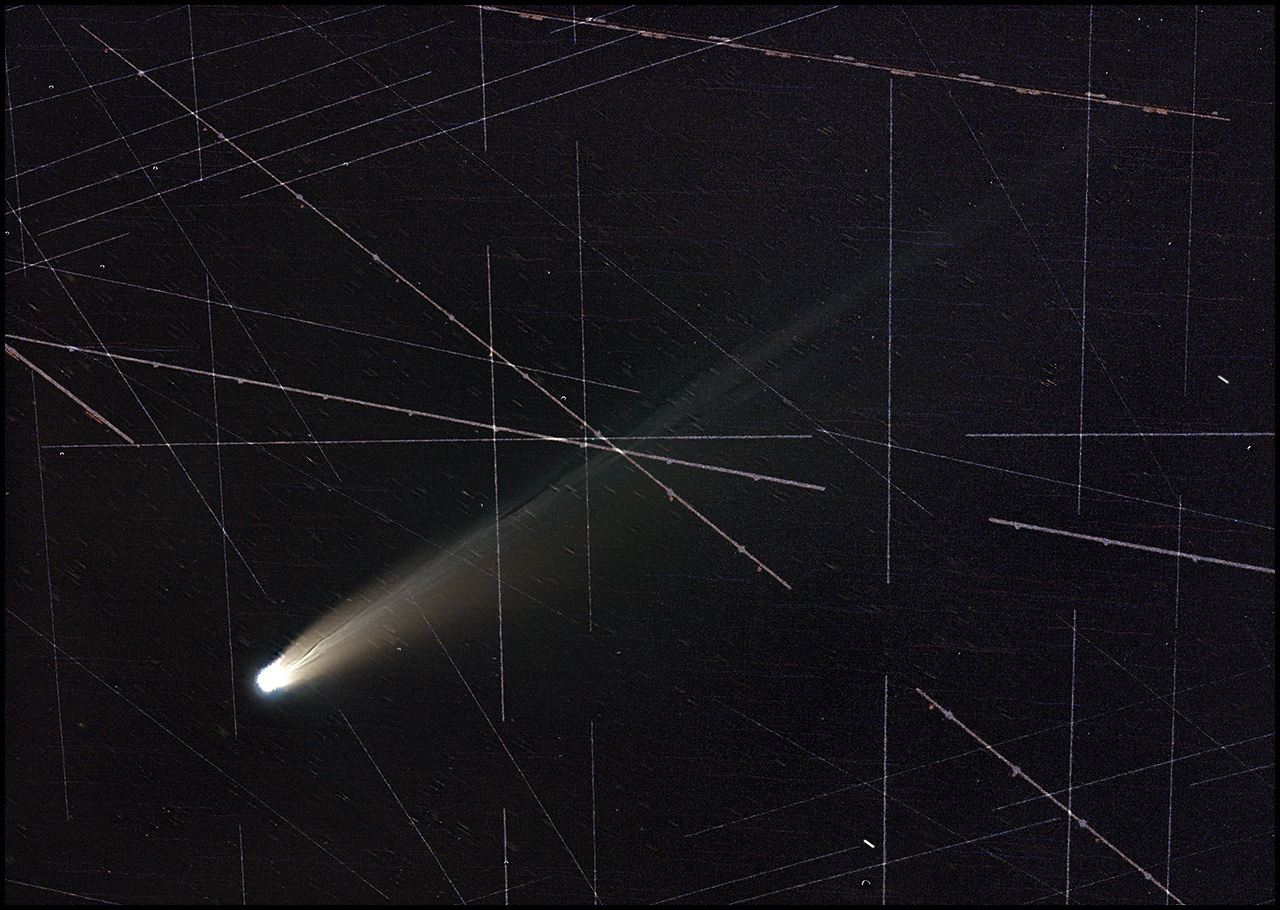Lemmon Twilight
10/22/2025. Comet 2025/A6 (Lemmon) made its closest pass to the Earth yesterday, and it was in a nice galaxy-rich field, but I wasn't ready for it. Tonight, I set the Wave 100i up for its first real-world actual photo attempt over by the community lot in a spot I expected to be shielded from boatyard lights and from which Arcturus would be clear of all the farther woods. The comet would be above to the left.
I couldn't see Polaris and there was no time to mess with a new-to-me blind polar alignment script, so I took my best guess, slewed to near Arcturus, centered that star, told the mount to do its best, and then swept up the comet with 14x70 binoculars.
It was my first look at it, and it was both brighter and bigger than I expected. I began with a twenty or thirty 5-second exposures with the 400mm F2.8 Nikkor, then ninety 10-second exposures as the sky darkened, and I finished with a dozen or so 15-second frames. Every time I looked through the viewfinder, I saw a satellite sailing through the frame. (I tossed the first 10, 10-second exposures since they seemed noticeably brighter than the rest. It always surprises me how fast the light changes as twilight deepens.)
For a flat, I aimed at the computer screen and averaged 12 frames. I stacked the take in PixInsight. I tried both stellar and cometary alignments. The latter captured far more detail. I processed the stack with options set to exclude interlopers but save bright pixels separately. Then I finished the comet photo before adding the satellites and aircraft back in. Here are both versions, with and without statistical filtration:

 400mm F2.8 Nikkor, Canon R6, ISO 3200. 80x10s 400mm F2.8 Nikkor, Canon R6, ISO 3200. 80x10s
Comet alignment in PixInsight, with and without statistical exclusion of transients
I used the Wave 100i via WiFi tonight. Neat. The only wire attached to the mount was a 12v power cable. It took all of five minutes to set up (not counting alignment) and it all packed away just as quickly.

Waiting for the comet. I know you can't see much here, but it's so clean!
I took the camera body off the 400mm to show you how clean it all is!
Sometimes things just work. Next: please let's nail down some guiding options.
10/24/2025. Once more into the breach. The WiFi connection is fine for driving the mount by hand, alignments, etc., but with the guide camera connected to the computer via USB, I can't get PHD2 to guide via WiFi. I tried both "Synscan App" and "on camera" without obvious success. Then I ran an ST4 cable from the guide camera to the guide port on the mount and re-selected the Synscan App in PHD2. That at least got everyuthing talking. Then I increased the calibration step to 4000ms and increased minimum movements to 0.25 seconds of time. Now things seem happy(ish), though I am sure they can be better. With the display scaled for seconds of arc, errors look large, but it is definitely guiding, and it appears to be guiding quite well. Errors shown in arcseconds look terrible, so I viewed errors in pixels instead. It helped me sleep better, and with a full-frame sensor working a focal length of only 400mm, life is easy. I have RA and Dec aggressiveness set to 100, hysteresis to 0, and my guide exposures are 1.5 seconds long (the preferred 0.5 second exposures can't cope with tonight's haze and thin clouds). FWIW: the 50mm guide telescope is mounted on a Losmandy D-plate extended out from the second saddle.
Here's a stack of 195 ten-second exposures (32.5 minutes) aimed at the head of the lyre through the haze. It's enough to reassure me that, at least for this wide-field configuration, guiding is spot on. Errors were fractional pixels in the ASI120MM binned 2x2 behind a guidescope with a 178mm focal length (pixels: 2x3.75u, 8.8"/pixel). Results for the 400mm on the R6 (6.56u, 3.4"/pixel) look excellent:

Make it big to see just how nicely the stars are tracked.
Now let's try some more reasonable subframes (30s, 60s...) to be sure the appearance of excellent guiding proceeds from precise acquisition rather than from post processing (thank you, BlurXterminator).
10/25/2025. Notes to self. While cleaning up the porch for Halloween and rearranging toyz around the Wave 100i, stuff I will want right soon has been stashed in Pelican cases under the 10-inch RC. In the big case at the bottom is the Mach1GTO. In the case above it is the 300mm Tamron as well as most of the solar kit (the 92mm TMB, Quark, and ASI178MM). In the smallest case is the ASIAir, a small-aperture stalk-mounted finder, various cables, adapters and a transformer/wall wart of uncertain provenance. In a Craftsman tool bag beside the hard cases are the counterweights and counterweight extension for the Mach1 (y'know like as if a 12 or 14 inch RC should get dropped off here, also of unknown provenance). So when you panic looking for some of this stuff, that's where it is.
A box of EOS lens caps is enroute from Brooklyn, because you can't have too many (they apparently evaporate). Now do the same for spare EOS-R caps when you think of it. Note that there are plenty of body caps around.
:: top :: |